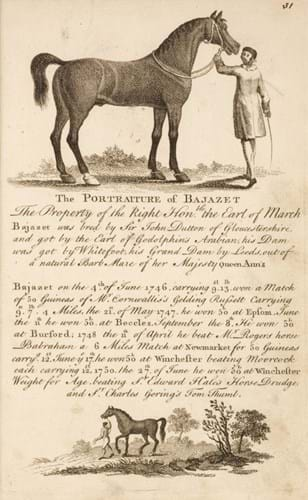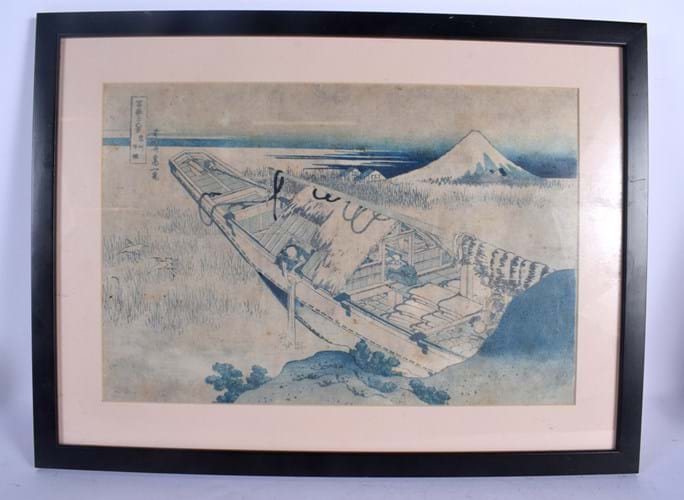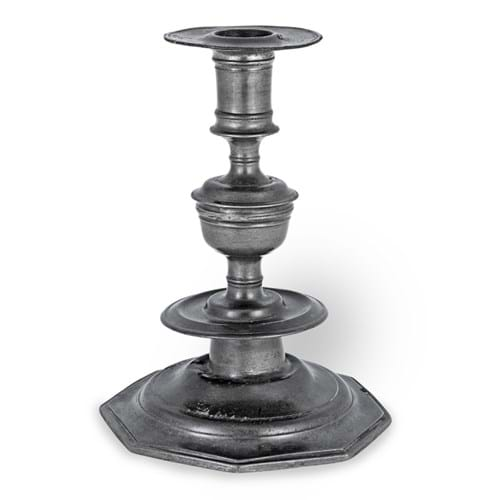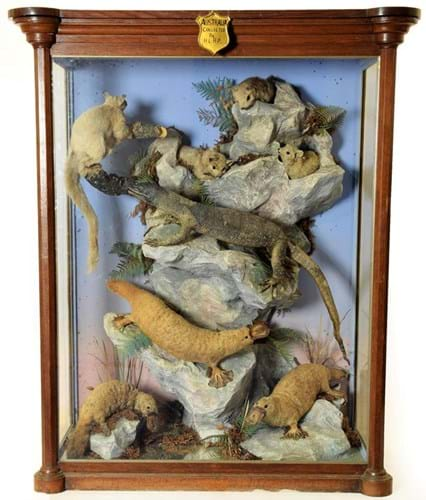1. The Sportsman’s Pocket Companion – £2500
This first edition copy of James Roberts’ The Sportsman’s Pocket Companion: Being a Striking Likeness or Portraiture of the most Eminent Race Horses and Stallions that ever were in this Kingdom was printed c.1760.
The 42 pages include 40 equestrian portraits. One of just two copies known, it featured in Dominic Winter’s sale titled Travel, Maps & Topographical Views, Antiquarian Literature, Cookery & Science in South Cerney on January 20. Estimated at £1500-2000, it took £2500.
2. Hokusai print – £6800
Although catalogued at Hannams in Selborne, Hampshire simply as ‘a 19th century Japanese woodblock print’, this 15 x 10in (38 x 24cm) scene of a boat with Mount Fuji beyond carried a signature that gave more clues to its famous author.
It that of the great Edo period ukiyo-e painter and printmaker Katsushika Hokusai (1760-1849). This print, known as Joshu Ushibori (Ushibori in Hitachi Province), was one of the Fugaku sanjurokkei (Thirty-Six Views of Mount Fuji) issued from c.1830-32. Hokusai’s most celebrated work, The Great Wave off Kanagawa, is part of the series.
The earliest prints in the Mount Fuji series were made with these blue tones known as aizuri-e. Prussian blue pigment had not long been introduced to Japan from Europe and Hokusai used it extensively. Once the publisher Nishimure Yohachi, was sure of the series' success, prints were made with multiple colours.
Estimated at just 50-75 at the sale on January 11 (the guide given to a dozen Japanese woodblock prints in the sale), it sold rather better at £6800 to a buyer on thesaleroom.com.
The price is a good one: versions of this print offered in recent specialist sales at Sotheby’s and Christie’s have hammered at £4000 each.
3. 1920s fountain pen – £8000
The deal struck in the 1920s between Ryosuke Namiki (1880-1954) of the Namiki Manufacturing Co and Alfred Dunhill to make luxury pens for the Western market created some of the most collectable of all fountain pens.
At a time when mechanisation and plastics were making pens cheaper, the pair hit upon the idea of creating deluxe items using the painstaking Japanese maki-e technique that involved sprinkling coloured metal flakes or powders onto wet lacquer.
This Dunhill-Namiki pen was offered by East Bristol Auctions on January 14.
It had the flat top associated with pens made during the 1920s, was relatively large at 5in (13cm) and is decorated – with the addition of abalone shell – with a dragon in gilt relief (takamaki-e) to the barrel and a mountainous scene to the cap. For three-dimensional decoration such as this, four, five, or even more layers of lacquer could be applied.
In addition to the Namiki logo that appears to the 14ct gold mounts, it is signed below the lever by the artist Shogo (b.1894) who joined the Namiki Co in 1928 and became the leading member of the firm’s Kokkokai group of decorators assembled by the master artist Gonroku Matsuda in 1931.
The pen did have a small crack to the lid, but it improved on hopes of £1500-2500 to bring £8000.
4. 17th century pewter candlestick – £16,000
The Oak Sale at Bonhams in Oxford on January 20 included this rare Charles II pewter candlestick c.1675 with the maker’s mark SB (possibly for Samuel Booth of York (fl.1671-79).
A virtually identical pair of 9in (22cm) candlesticks, without the detachable sconce, by the same maker, are in The Worshipful Company of Pewterers collection. Estimated at £6000-8000, it sold at £16,000.
5. Australian animal taxidermy – £15,000
Hodnet Hall in Shropshire, home of the Heber family for centuries, formed its natural history collection during the golden era of taxidermy – from the early 1870s to the 1920s. Several Victorian and Edwardian generations of the family were international travellers including Hugh Lewis Heber-Percy (1853-1925) who made trips to Australia, Africa, India and the Far East.
An inscribed copper shield to this 3ft 7in x 4ft 2in (1.04 x 1.32m) floor-standing case of three platypus, a goanna, flying squirrel and three quolls reads Australia, Collected by HLHP. The case itself is signed and dated to interior floor H Shaw, Salop, (18)76. Henry Shaw (1812 -87) was a notable local name: operating from the High Street in Shrewsbury his mounts included those in the collections at Hawkstone Park and Ludlow Museum.
It was sold at Tennants in Leyburn on January 15 as part of a 116-lot sale of taxidermy from Hodnet Hall. Estimated at £8000-12,000, it went to a European private buyer via thesaleroom.com at £15,000.










